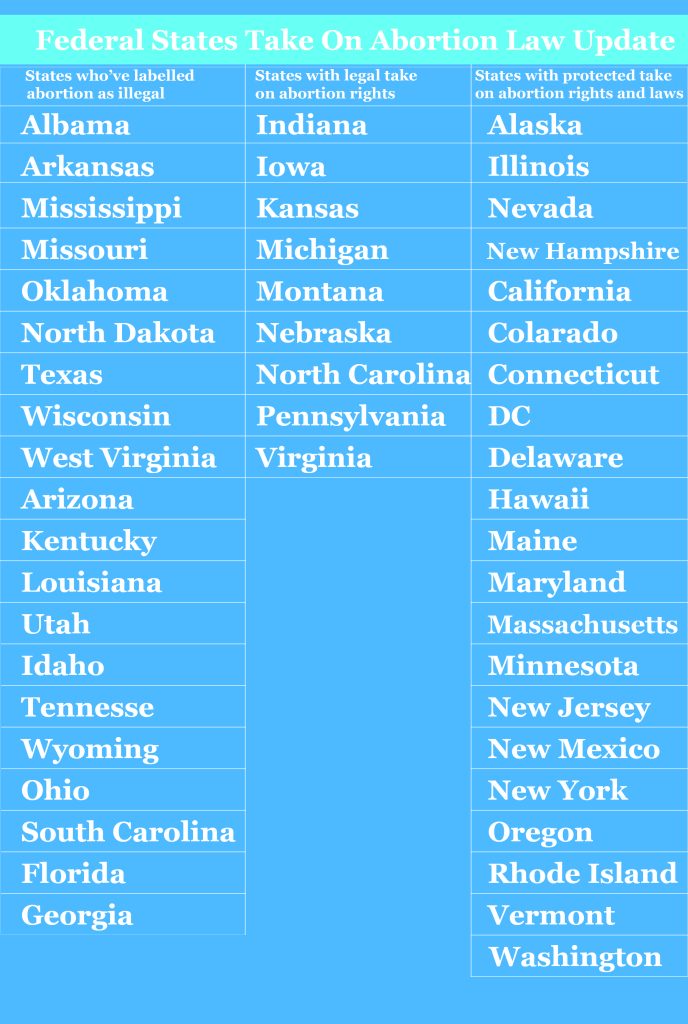
Heads in the hand, trembling lips, and dejected looks on the people’s faces. Some sigh, some cry when on June 24, 2022, the U.S. supreme court demolish the Roe Vs Wade case, the landmark decision of 1973 concerning abortion rights. The 1973 decision determined the “Right to Abortion” is legal in the United States. The ruling was significant in many ways. Moreover, it gave women the choice of whether they wanted to opt in or opt-out. It strengthened their identity of being a woman. However, the recent judgment passed by the U.S Supreme Court demoralizes the same sentiment of identity, privacy, and the question of being a woman. And what does it mean to be a woman in the twenty-first Century?
In recent times, certain reproductive and privacy rights developments have fumed a wide range of debates around the country. United States Supreme Court ruled out a notification that gives abortion an unconstitutional status among the constitutional rights. This update gives access to federal states to decide whether abortion should have illegal status or not. Abortion rights or reproductive rights didn’t prevail from the very beginning. After a series of legal disagreements and several cases, abortion rights stumbled into the constitutional category.
The landmark lawsuit that changed the flow of abortion rights in states was Roe versus Wade. This lawsuit follows a woman who identifies as Roe (pseudonym), an unmarried pregnant young woman who challenged prevailing Texas and other states’ abortion laws representing herself and others. This case is significant as it gave evident credibility to the “Right To Privacy”, which allows a person to decide whether to have an abortion or not.
Texas state put forward arguments emphasizing maintaining healthcare and medical standards. In the ode of Amendment 14, a fetus was recognized as a person, a living being. And lastly, protecting prenatal life is a state’s interest. These were the arguments Texas presented. While on the other hand, Roe recognized the invasion of Amendment 14 by violating the right to privacy. She also identified the violation of the Bill of Rights, which safeguards marital, sexual, and familial privacy.
By the end of the case, the court actively identified and acknowledged the existence of a right to privacy under Amendment 14’s Due Process Clause. Also, with this acknowledgment, the inclusion of pregnancy rights into the right to privacy was a landmark development at that time. This case was identified as legal activism as it spoke about women’s reproductive rights in an opinionated manner. The judicial interpretation was that abortion was labeled as legal. Yet many opponents have advocated making abortion laws stricter by levying certain limitations. As a result, many prominent states have placed restrictions on abortion procedures in certain circumstances, including parental notification requirements, mandatory disclosure of abortion-related risk factors, and restrictions on late-term abortions.
Federal states take over abortion law update

In certain states, the status remains illegal for rape and incest victims. This reaction of federal states is questioned by people in effect and the world globally. States with a legal take on Abortion rights are states who have given preferences to the right to privacy. States with protected take on abortions right and laws are states who are possibly in favor of preserving the legal status of abortion procedures in their respective states.
The right to safe and legal abortion is a fundamental right accredited by numerous international organizations, treaties, and national-level constitutions worldwide. This right solely safeguards women from discrimination, the right to life, liberty, privacy, and freedom from prejudice-based treatment. Nearly 970 million women that are 59% of women prevailing in reproductive age in current times live in countries where women have safe and sane access to abortion procedures. While on the other hand, another significant number is that 700 million women (41% of women) have access to abortion facilities under restrictive circumstances. Not even the mere access. Certain restrictions don’t control the number of deaths by abortion yet end up making the whole process quite straining for a woman. According to World Health Organization, nearly 23,000 die of unsafe abortion procedures, and around 10,000 deal with health risk complications.
How can corporations help their employee?
Corporations generally have a reliant approach toward abortion rights. This approach is quite progressive yet liberal. The certain view reflects that women are viewed as equally qualified assets for corporations. Certainly, this lenient approach is quite needed after the Supreme Court’s ruling.
Following are the adaptive measures that could be opted by corporations to support abortion rights:
- Affordable Care Act is a clause in corporations that includes healthcare and medical insurance for the prevailing employees. Internal audits ensure the relevance of health insurance for female employees and check on the contraceptive inclusions in the policy. Or corporations can fund or sponsor or bail employees for travel related to pregnancy-related medical procedures to support their respective employees reliably.
- Supportive and progressive culture in corporations should also promote word around pregnancy or abortion-related themes. Firstly, it would help to break the stigma around such sensitive matters and enlighten people with certain developments. Second, this would educate employees about what is included in their health insurance policies.
- And lastly, on their end, the corporation can provide the amenity of paid parental leave to employees. It would positively project productivity and strengthen employees’ trust in an organization. Also, corporations can redesign their workplace to support female employees who are mothers. Establishing daycare centers in the workplace and infant care sections in washrooms are mere directory changes that the corporations could adapt.




